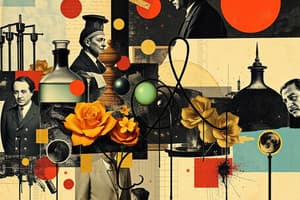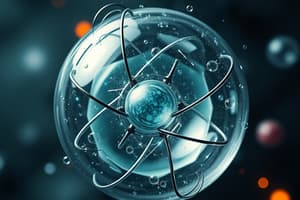Podcast
Questions and Answers
Which scientist proposed that matter is made of atomos, meaning 'indivisible'?
Which scientist proposed that matter is made of atomos, meaning 'indivisible'?
- Democritus (correct)
- J.J. Thomson
- John Dalton
- James Chadwick
John Dalton discovered the neutron.
John Dalton discovered the neutron.
False (B)
What significant experiment did Ernest Rutherford conduct to explore atomic structure?
What significant experiment did Ernest Rutherford conduct to explore atomic structure?
Gold Foil Experiment
J.J. Thomson is associated with the __________ Model.
J.J. Thomson is associated with the __________ Model.
Which of these scientists contributed to the discovery of radioactivity?
Which of these scientists contributed to the discovery of radioactivity?
The planetary model of the atom was proposed by James Chadwick.
The planetary model of the atom was proposed by James Chadwick.
What particle did James Chadwick discover?
What particle did James Chadwick discover?
Match the scientists with their respective contributions:
Match the scientists with their respective contributions:
What did Max Planck propose about energy emission?
What did Max Planck propose about energy emission?
The photoelectric effect could be explained using the current model of light before Einstein.
The photoelectric effect could be explained using the current model of light before Einstein.
What are photons?
What are photons?
Electrons can only exist in specific orbits with specific amounts of energy associated with them. These orbits are referred to as __________.
Electrons can only exist in specific orbits with specific amounts of energy associated with them. These orbits are referred to as __________.
What happens when neon gas is excited?
What happens when neon gas is excited?
Match the following scientists with their contributions:
Match the following scientists with their contributions:
Electrons can absorb only a part of a photon in their interactions with matter.
Electrons can absorb only a part of a photon in their interactions with matter.
When white light is dispersed through a prism, it produces a __________ spectrum.
When white light is dispersed through a prism, it produces a __________ spectrum.
Study Notes
Atomic Theory Timeline
- Democritus ( ~400 BC): Proposed matter is made of indivisible particles called "atomos".
- John Dalton (1803): Developed the atomic theory stating that elements consist of atoms that cannot be divided, created, or destroyed.
- J.J. Thomson (1897): Discovered the electron using the cathode ray tube experiment. He found negatively charged particles within atoms.
- Marie Curie and Henri Becquerel (1896): Discovered radioactivity, finding that some elements emit positively charged alpha particles, negatively charged beta particles, and electromagnetic radiation (gamma rays).
- Ernest Rutherford (1911): Conducted the gold foil experiment. This experiment suggested the atom is mostly empty space, with a dense, positively charged nucleus.
- James Chadwick (1932): Discovered the neutron, a neutrally charged particle found in the nucleus.
- Max Planck (1900): Proposed that energy is emitted in discrete packets (quanta), not continuously. This was a key concept in the development of quantum mechanics.
Atomic Models
- Billiard Ball Model (Dalton): Depicted atoms as solid, indivisible spheres.
- Blueberry Muffin Model (Thomson): Visualised atoms as a positively charged "dough" with negatively charged electrons scattered throughout.
- Planetary/Nuclear Model (Rutherford): Showed an atom with a tiny, positively charged nucleus at the center and electrons orbiting it like planets around the sun.
- Bohr Model (Bohr): Electrons orbit the nucleus in specific energy levels, and can jump between energy levels by absorbing or emitting photons of light.
Key Concepts
- Radioactivity: The property of some elements to spontaneously emit particles and radiation.
- Nucleus: The dense, positively charged center of an atom.
- Electron: A negatively charged particle found orbiting the nucleus.
- Neutron: A neutrally charged particle found in the nucleus.
- Quantized Energy: Energy that exists only in discrete amounts (not continuous).
- Photon: A packet of light energy.
Studying That Suits You
Use AI to generate personalized quizzes and flashcards to suit your learning preferences.




